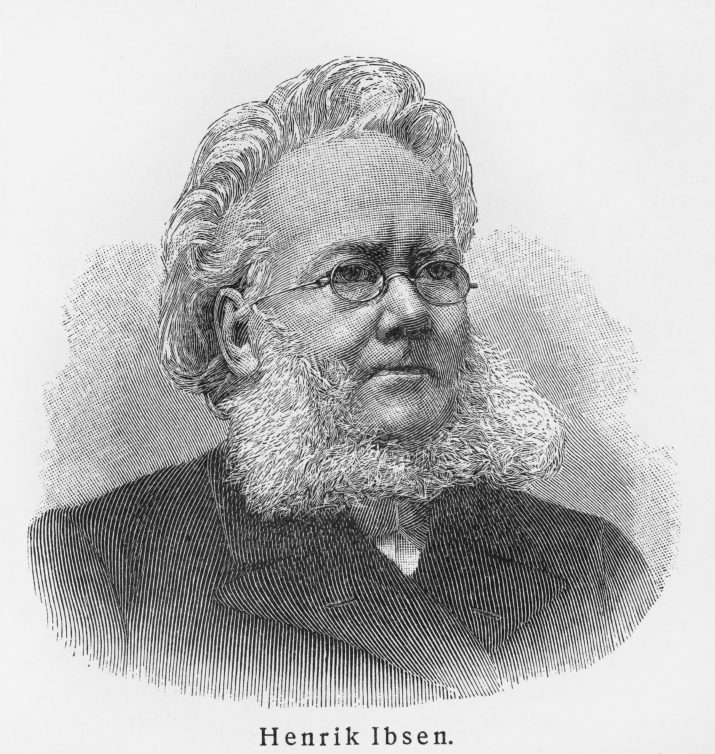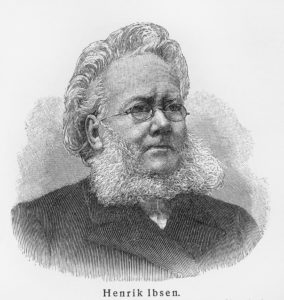

The most staged dramatist after Shakespeare, the Norwegian playwright Henrik Ibsen is regarded as the father of modern drama. Since its premiere in 1879, his most popular play A Doll’s House has been performed and debated across the world. Teaching a course on world literature led me to ask what the play itself has to say about the world, how that aligns with the play’s attainment to the status of worldliness, and how practices of world literature disclose the changing fault lines of capitalism, colonial ideologies, and hegemony.
Ibsen’s plays are known as domestic dramas. A Doll’s House takes place in the living room of Nora and Torvald Helmer, probably in Christiania or today’s Oslo, around 1879. In the span of a few days, Nora goes from understanding herself primarily as a wife and mother to an individual in need of self-development through work, independence, and exposure to the world outside the home. The world of the play magnifies domestic space—both in terms of the home and the nation. Yet there is a parallel between the plot of the play and Norway’s position in international commerce at the time. I found that references to banking suggested a story of anxiety about Norway’s very international role in shipping between European centers of empire and colonies. If we enlarge the spatial field of analysis from the living room to global trade, the late-nineteenth century bourgeois morality that underlies gender inequity in the play, one of its main subjects, appears to be connected to the wider stakes of capital and empire.
In the backstory of A Doll’s House, Nora has secretly borrowed money from Nils Krogstad to save her husband’s life. The problem is that she forged her father’s signature to have a guarantor. As a woman, she cannot borrow on her own. Years later, Krogstad threatens to reveal her forgery as revenge for Torvald firing him from the bank. Torvald, determined to submit to blackmail for fear of being blamed, disowns Nora, and “forgives” her once the threat to his reputation has passed. In short order, Nora learns that her values conflict with those of law and commerce. As a woman, she bears the brunt of a hypocritical moral code. But why that code has such force is only implied. In the case of the forgery, the reliability of one’s good name underwrites financial exchange. Torvald is the new director of a commercial bank. What might we see if we notice that commercial banks served an expanding middle class whose domestic wealth depended on European colonialism? This connection isn’t obvious because of the indirect yet significant form of Norway’s economic embedding in European imperialism. Therefore, I want to highlight recent efforts in Norway and across northern Europe to rethink the history of colonialism. This scholarship invites reconsideration of how we have read Ibsen. Rather than turn away from the question of Nora as a feminist prototype, I am interested in how gender domesticates global capitalism and empire. The peripheral position of the economic discourse to domesticity in the play is in synchrony with the periphery of global capitalism to the play’s domestic foreground and the relative occlusion of European imperialism in Norway’s history. Leaving her husband, children, and home at the end of the play, Nora has been read as a figure for the collapse of the family or the logical expansion of the model of the individual. Either way, we remain in the paradigm of the late-nineteenth century Norwegian, and more broadly, European middle class. An issue in this paradigm is whether the ideal of a sanctified sphere of interiority, embodied by domesticity, can withstand the rise of women’s emancipation. For us to better understand and move beyond this story of bourgeois crisis, it needs an outside.
The framework known as hitchhiking imperialism lies outside Nora’s home and her objective to return to the town of her childhood to find work. Yet it connects the domestic economy that Nora plans to join to a wider hegemonic network. While major empires like the British and French controlled people and land, other European powers accrued wealth through the enlarged economy of empire. “By hitchhiking on the back of the British, French and German empires, the little Scandinavian monarchies benefitted greatly from European colonialism,” Miles Macallister writes.[1] When A Doll’s House premiered in 1879, Norway was reaching an apex in the global shipping industry. We learn from the essays in Navigating Colonial Orders that in 1880, “almost 80 percent of the gross revenue of the Norwegian shipping industry was made in cross-trade, . . . interconnecting the colonies and the colonizing nations in Europe.”[2] If some empires became wealthy by extracting natural resources, commodities, and, with that logic, human labor, Norway transported the first two. In 1879, the Norwegian merchant fleet was the third largest in tonnage after the British and the US. This fact may surprise, since Norway is often understood as a provincial nation. From 1536 to 1814, Norway was subsumed in the real union of Denmark-Norway. It was subsequently forced into a freer union with Sweden until 1905. Accounts of colonialism in northern Europe mostly emphasize Norway’s subjection to imperialism. However, Norway “possessed” the Faroe Islands, Greenland, and Iceland. Furthermore, in their own borders, Norway and nearby countries colonized the land of indigenous nations. The Saami continue to contest harmful incursions by the state. Recent studies point to Norwegian participation in Danish colonies on three continents.[3] If Norway did not traffic in slaves or possess slave ships, Denmark-Norway did. The Fredensborg slave ship is a well-documented example. Norway’s relative autonomy—“neither quite dependent nor quite independent”—has led Toril Moi to append a question mark, “Postcolonial Norway?” when describing the country in Ibsen’s day.[4] A nuanced story is lately emerging about Denmark-Norway, given Norway’s prosperity in the union. Likewise, a complicated history predates the simplified story that oil saved the economy.
In the spirit of existing research on international stagings of Ibsen and orientalism in northern Europe, we may turn to Ibsen’s plays to understand forms of Nordic imperialism.[5] Pillars of Society premiered two years before A Doll’s House. Its story enmeshes imperial trade and Norwegian society. Pillars of Society takes place in a shipping town. Under repair in the shipyard, two sea vessels bear the names the Indian Girl and Palm Tree, connoting an orientalist view of seafaring. Reflecting on the scope of her life, Martha Bernick comments, “I often wish I was far out on the wild sea.” However, the space of the ocean and imperial trade routes is quickly reduced to metaphor.
The wild sea—of course you don’t mean that literally. You mean the vast, surging tide of human society in which so many go down. . . . No, the truth of it is, we’re better off sitting here, in the cool of this room.
In this dialogue, the association of women with the domestic sphere assimilates the expansion (into the “wild”) of free trade imperialism by sea to a domestic scale. Down to size, the inside is the home and the outside, though commercially connected with western colonial expansion, becomes Norwegian society “down there in the street.” A related negotiation of domestic space takes place in A Doll’s House. Scant reference to imperialism does not make it irrelevant. From the standpoint of retrospection, we may see how the crisis of the home in A Doll’s House converges with factors offstage in Norway’s open economy. Domestic space overshadows and narratively excludes Norway’s economic embedding in empire. However, Ibsen exposes the artificial construction of domesticity that underlies this dynamic. My proposal to change the geographic scale of interpretation has footing in Ibsen’s description of space. The metaphor of a doll house implies the artificiality that dominates within the boundaries of the home and, likewise, the symbolic zone of the stage and theater as another kind of doll house of playacting. The self-reflexive meaning of the doll house insinuates that the problems in the play cannot be contained by the Helmers’ “doll house” or by a work of art. Indeed, the threat posed by Nora’s departure was felt so strongly that an alternate ending was staged in Germany.
A political economy connects the bourgeois crisis of Nora leaving home, its precipitation by her use of a financial instrument, and Torvald’s new position at the bank. In the field of Ibsen studies, several essays analyze the construction of domestic space through gender and commercial banking.[6] Yet, none questions what is so pressing to me, given what we know about empire and the growth of the European middle class, and, concomitantly, its institutions like the commercial bank. Lost to most English translations is the type of bank where Torvald works. It is a commercial joint stock bank, aptly named Aktiebanken, or the joint stock bank. An Economic History of Norway sheds some light on commercial banking. According to Fritz Hodne, commercial joint stock banks expanded in response to the liquidity crisis of 1856, ensuing from the Crimean War. Hodne notes the effects:
Especially the newer businessmen, dealing in colonial goods and textiles, were relieved; the older houses had gained full emancipation from foreign banking connections already in the forties . . . . The function of short term commodity credit was, so to speak, shifted from Hamburg, London, Copenhagen and Altona up to Norwegian towns, and with it, the profits involved in commercial banking.[7]
The emergence of the new banks meant that Norwegian businesses could use colonial materials in production and manufacture them as output at home with less reliance on European finance metropoles abroad. In providing this information, my aim is not to overstate the significance of banking for imperialism, or vice versa. It is, rather, to aver Torvald’s central role as the new bank director to link Norwegians with greater ease and to a greater extent to imperial commerce and wealth. Torvald would enable Norwegian entrepreneurs to tap into imperial industries and economies. He would also facilitate the domestic accrual of surplus wealth for local stockholders investing in such ventures. Joint stock banks paid high dividends.
How should we understand the indirect relationships between the new commercial banks, their domestic function, and Norway’s very international wealth? We can begin by perceiving some of their links. Norway’s first commercial bank Christiania Bank & Kreditkasse was founded by the merchants Handelens Venner. They also founded Oslo’s first marine insurance company Søforsikringsselskabet i Christiania. Earlier, a founder of the group created a cotton mill, which would have used colonial textiles. Here we see the conditions for creating a commercial bank converge with the insurance of the merchant fleet and colonial industry. Economic historians of Norway seem to agree that the commercial banking sector was relatively small in the late nineteenth century, though their conclusions vary from there. To this end, our concern is not whether Norway’s financial organization was “backwards,” the subject of much economic literature, though it bears noting that this term is not descriptive, but ideological. What is relevant is the fact that concerns about economic backwardness existed at the time that Ibsen made Torvald become the director of one of the new commercial banks. Unlike Pillars of Society, A Doll’s House is not about the shipping industry. However, the economic discourse tends to couple concerns about shipping and banking. So much is this the case that one historian argued that the backwardness theory is misconceived because the shipping industry raised capital for steamships without relying on commercial banks.[8] The rise of steam was a source of uncertainty about the future of Norwegian shipping. In 1880, the year after A Doll’s House premiered, Norwegian investment in steam eclipsed that in sail for the first time. The transition to steam was accompanied by the creation of joint stock ship and shipping companies. Given the coinciding discourses on shipping and banking, it seems to me that joint stock shipping companies and joint stock banks belonged mutually to a broader discourse on “modernizing” the economy. Among other things, modernization seemed (rightly or not) to be necessary to adapt to changes in global shipping.
Is the colonial embedding, both real and discursive, of domestic commercial banks relevant to our understanding of A Doll’s House? Of course, it is. Edward Said transformed our ability to recognize the force of empire in Jane Austen’s satires of social mores and changing class structure through his account of the dislocation of plantation slavery in Mansfield Park.[9] Nora’s anchoring to the world of international and imperial commerce, and the gendering of her domestic myopia of the world, should be a point of anchor for us too. The crisis in the Helmers’ home is a microcosm of a larger contradiction between the value of interiority in liberal philosophy and exploitation in modern global capitalism and imperialism. Lisa Lowe points out that imperialism “produced the assets for the bourgeois republics in Europe and North America out of which intimacy, as liberal possessive individualism, became the hallmark.”[10] This conjuncture situates how capitalism on the periphery of the home comes to upset the pretenses of the Helmers’ intimacy. According to Lowe’s schema, the occlusion of the world and its network of colonial relations is the very work of liberal domesticity. Once you look at domesticity and global relations, other examples come into focus. Nora saved Torvald’s life by funding their stay in Italy, heeding doctors’ orders to “go south.” The trip to Italy and the orientalizing of southern Europe in the tarantella, as a seductive dance that Nora learned there, index the overlay of worlds. A foreign, orientalized world underwrites the domesticity of the play, while Nora’s ideological milieu—what she is told about commerce and law—comprises the “world” whose difficulties, she is told, she does not understand. Another index of orientalism is offered by the Helmers’ Chinese figures and Torvald’s statements that the act of knitting is “ugly” and that there is “something Chinese about it.” His opinion swiftly trivializes and genders the idea of China and the domestic sphere through women’s leisure occupation. Another viewpoint that Ibsen subtly mocks is social Darwinism. In the play, social Darwinism fills in moral justifications of misfortune where there could be recognition of the unequal effects of capitalism and empire. These details lead me back to a question of how we conceive of world literature when we put Ibsen on the syllabus. Is it Goethe’s idea of trading the best writings of nations? Should we conclude that realist-modernist literature like A Doll’s House holds a privileged position in world literature? Rather than building up the category of world literature, I see Nora’s disillusionment as the impetus for building down from the liberal worldview that comes under pressure in A Doll’s House to its constitutive parts across the world.
Being in dialogue with feminist, antiracist students motivated me to follow the implications of the layered worldviews in Ibsen’s drama. Does Nora’s decision to leave home reinforce the domestic sphere of the nation as the outer counterpart to the inner sphere of the home? Does it assimilate the woman question in the disjuncture between liberal domesticity and colonialism and free trade imperialism? For those who view characters not merely as artistic creations but as models of the human, this question may complicate conceptions of Nora as a feminist model. Gender is a portal into the contradictions of Nora’s world. Her objectification as a housewife is untenable because of its latent contradiction with ideas of individualism. In her play What Happened After Nora Left Her Husband, the Austrian writer Elfriede Jelinek stages the aftermath of Nora’s departure in a complex historical collage. Where Ibsen portrays the contradictions of bourgeois morality, Jelinek has women workers tell Nora about her crisis, “Only the middle classes have got time for that.”[11] Ibsen’s play does not disagree, but it resolves the problem psychologically. Because Nora’s friend Mrs. Linde already has experience of the world, having had to work as a widow to support her relations, she can choose an enlightened marriage, intertwining her life with Krogstad’s for the spiritual value of a shared home while continuing to work. In contrast, Nora leaves to find out, in one widely used translation, “who is right, the world or I.” Her decision is brave. She voices opposition to the world when declaring an intent to experience it. She also declares an objective to learn from the world. For Jelinek and others, the threshold at the end of the play signposts the economic conditions of the world. The occlusion of these conditions appears to be a function of the idealization of domesticity. Yet we know this already because Nora has been navigating the world of commerce, repaying her loan, in secret to maintain her husband’s idea of the domestic sphere since before the story has begun. From this standpoint, Nora stands as a synecdoche of Nor-way.
Michele Chinitz is a PhD candidate in English at The Graduate Center, CUNY. She teaches at the City College of New York.
References
[1] Macallister, Miles, “The Scandinavians ‘hitchhiked’ their way to the boons of empire,” Aeon, January 31, 2018.
[2] Kjerland, Kirsten Alsaker and Bjørn Enge Bertelsen, eds., Navigating Colonial Orders: Norwegian Entrepreneurship in Africa and Oceania (Berghahn, 2015), 50.
[3] Kjerland and Bertelsen; Körber, Lill-Ann, “Scandinavia and the Slave Trade,” Goethe-Institut, February 2020; Loftsdóttir, Kristín and Lars Jensen, eds., Whiteness and Postcolonialism in the Nordic Region Exceptionalism, Migrant Others and National Identities (Routledge, 2016).
[4] Moi, Toril, Henrik Ibsen and the Birth of Modernism: Art, Theater, Philosophy (Oxford University Press, 2006), 39.
[5] Helland, Frode, Ibsen in Practice: Relational Readings of Performance, Cultural Encounters and Power (Bloomsbury, 2015); Oxfeldt, Elisabeth, Nordic Orientalism: Paris and the Cosmopolitan Imagination 1800-1900 (Museum Tusculanum Press, 2005).
[6] Westerståhl Stenport, Anna, “The Sexonomics of Et dukkehjem: Money, the Domestic Sphere and Prostitution,” Edda: Nordisk tidsskrift for litteraturforskning 93.4 (2006): 339-53; Fodstad, Lars August, “Economic Extensions in Space and Time: Mediating Value in Pillars of the Community and A Doll’s House,” Ibsen Studies 20.2 (2020): 110-53.
[7] Hodne, Fritz, An Economic History of Norway 1815-1970 (1976), 355.
[8] Nordvik, Helge W., “The Banking System, Industrialization and Economic Growth in Norway, 1850-1914,” Scandinavian Economic History Review 41.1 (1993), 64.
[9] Said, Edward, Culture and Imperialism, Vintage, 1994.
[10] Lowe, Lisa, The Intimacy of Four Continents (Duke University Press, 2015), 20.
[11] Jelinek, Elfriede, What Happened After Nora Left Her Husband, trans. by Tinch Minter in Plays By Women: Volume Ten (Methuen, 1994), 27.




